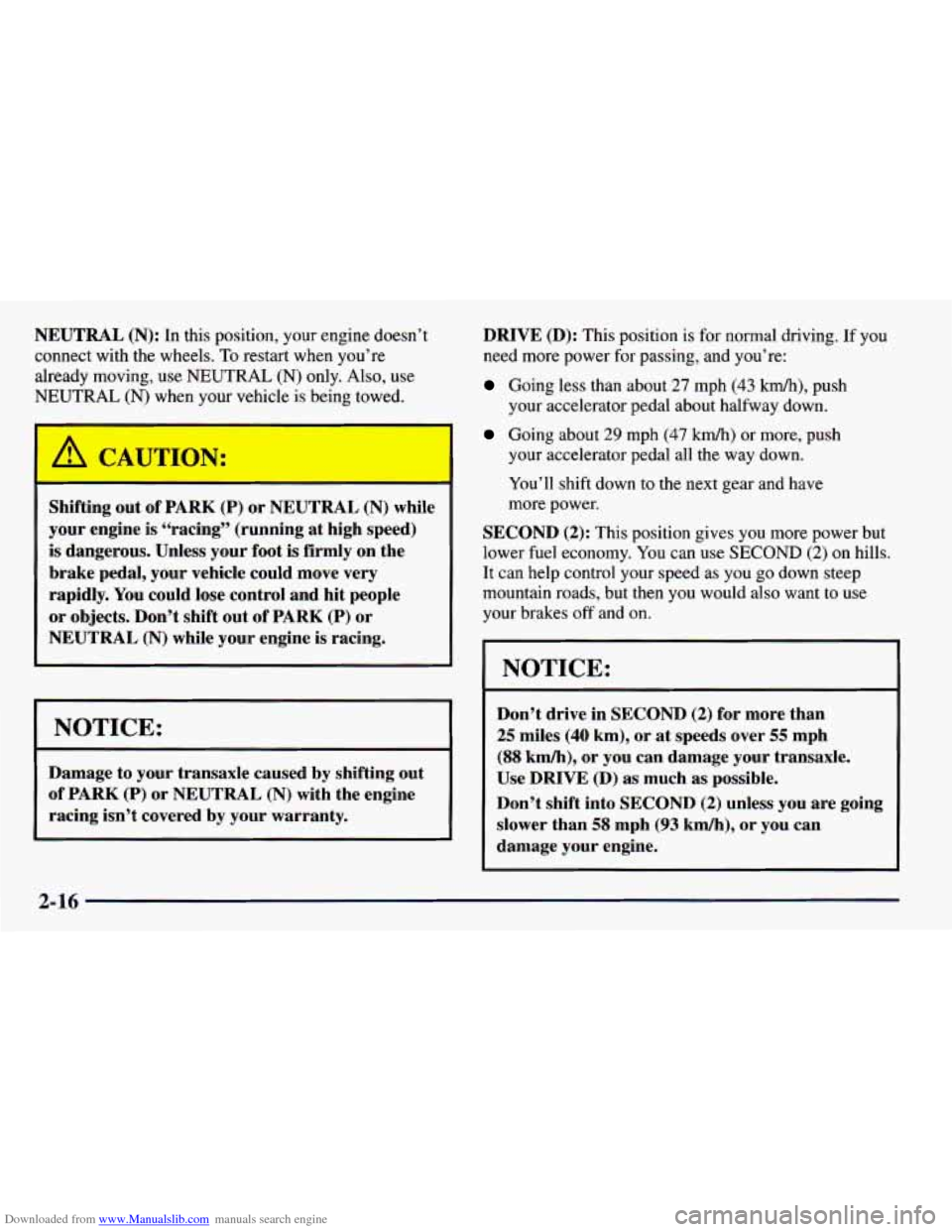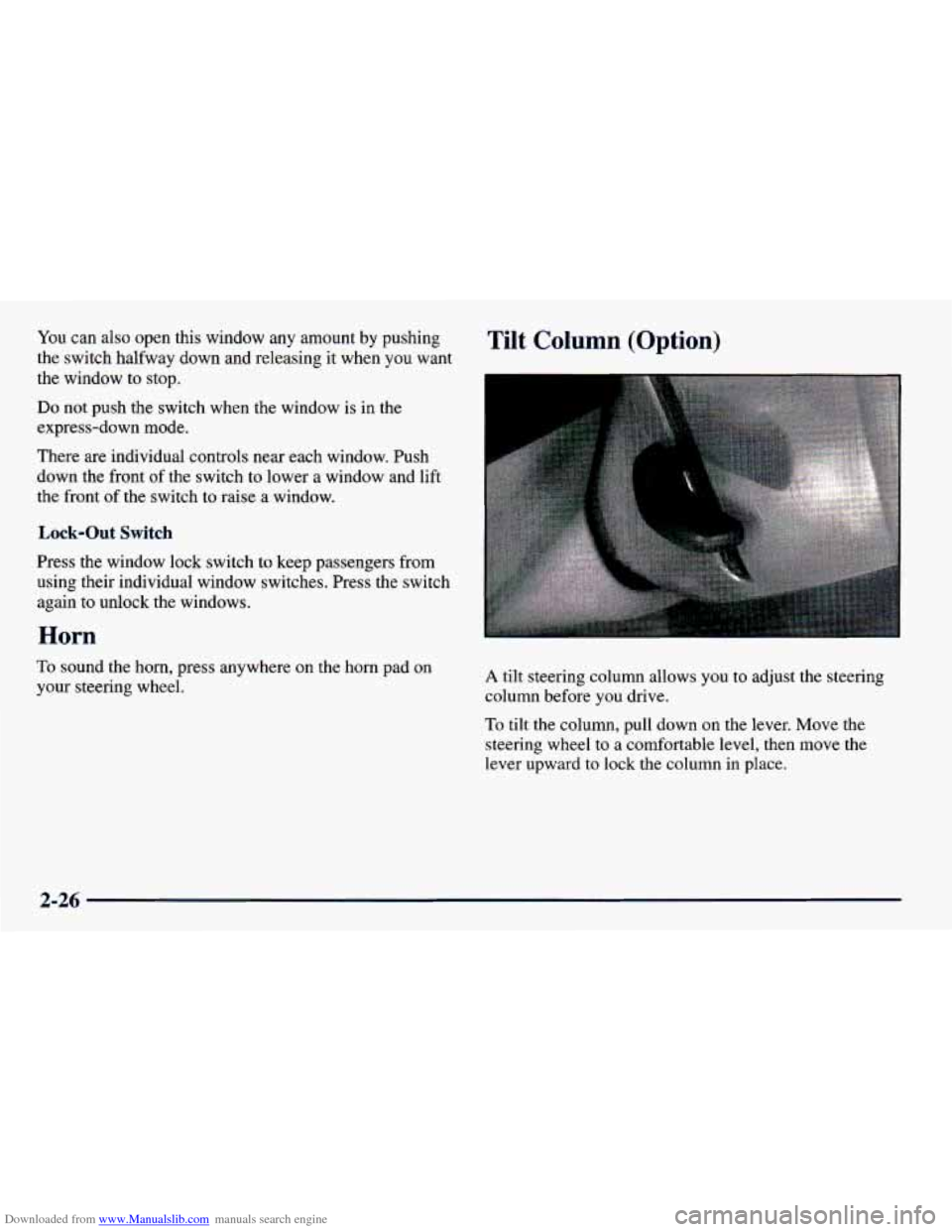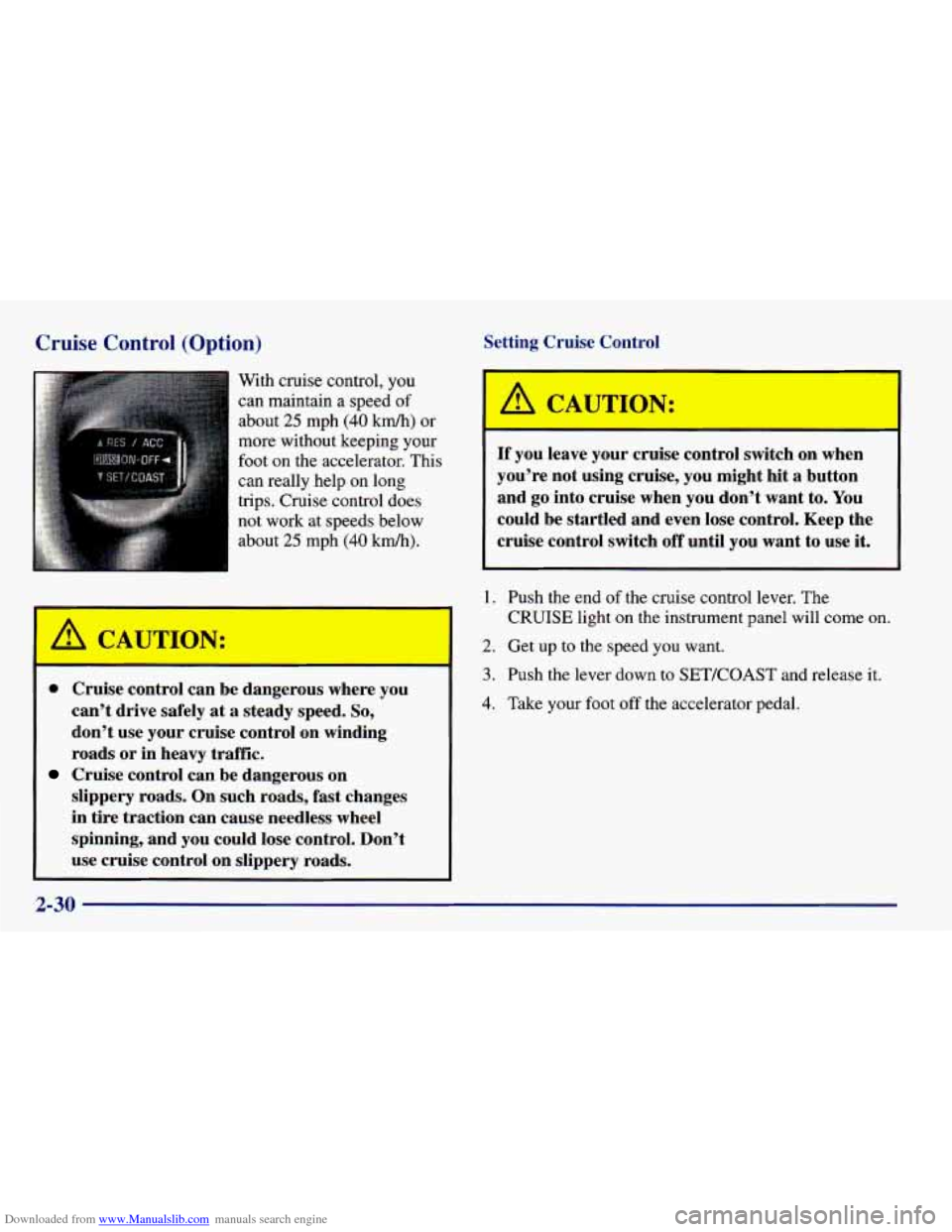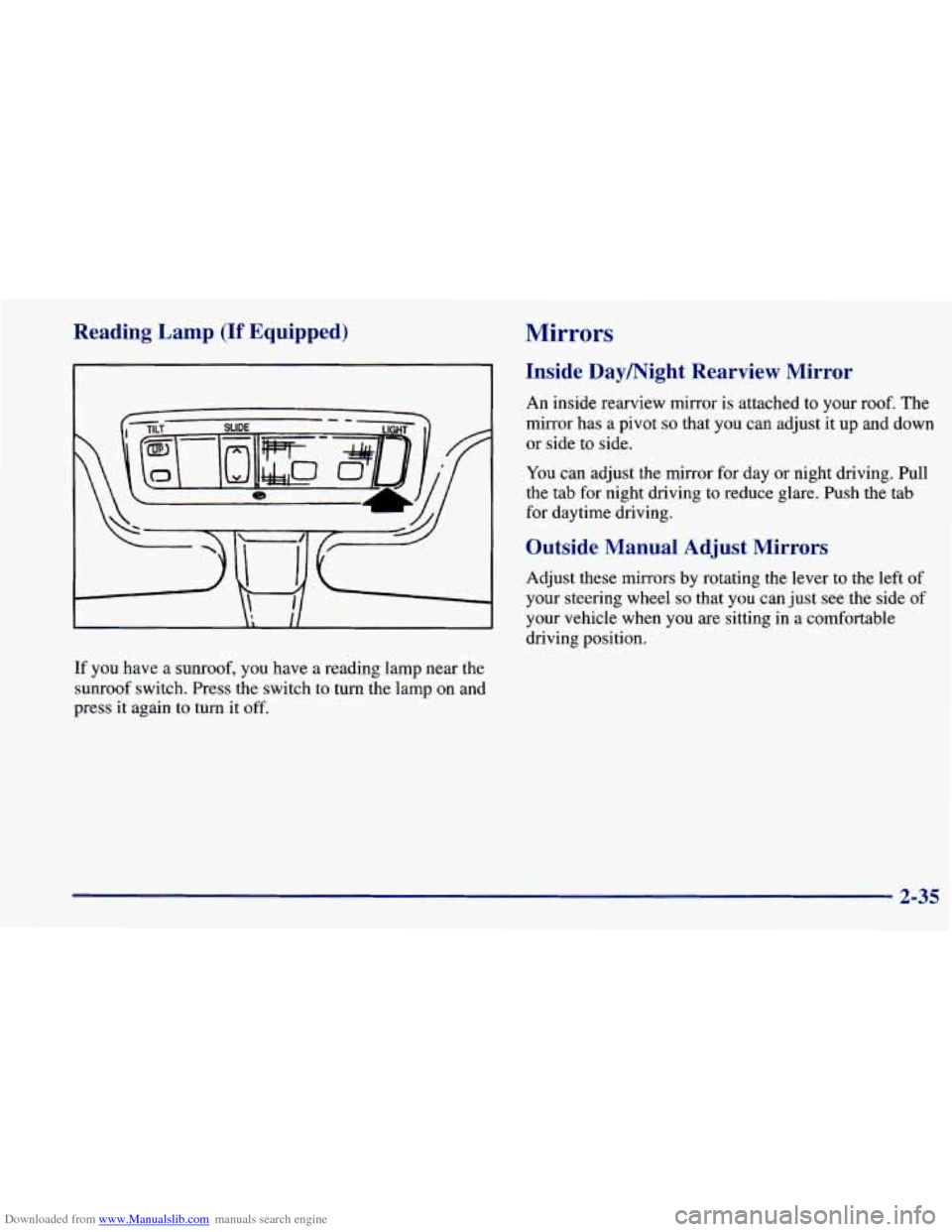1998 CHEVROLET PRIZM wheel
[x] Cancel search: wheelPage 89 of 364

Downloaded from www.Manualslib.com manuals search engine New Vehicle “Break-In”
NOTICE:
Your vehicle doesn’t need an elaborate
“break-in.” But it will perform better in the long
run
if you follow these guidelines:
Don’t drive at any one speed -- fast or
slow
-- for the first 500 miles (805 km).
Don’t make full-throttle starts.
200 miles (322 km) or so. During this time
your new brake linings aren’t yet broken
in. Hard stops with new linings can mean
premature wear and earlier replacement.
Follow this breaking-in guideline every
time you get new brake linings.
Don’t tow a trailer during break-in. See
“Towing a Trailer” in the Index for
more information.
Avoid making hard stops for the first
Ignition Switch
With the key in the ignition switch, you can turn the
switch to
four positions.
W
LOCK (A): This is the only position from which you
can remove the key. This locks your steering wheel,
ignition and automatic transaxle.
Push in the ignition
switch as you
turn the it toward you.
If you have an automatic transaxle, the ignition switch
can’t be turned to
LOCK unless the shift lever is in
the
PARK (P).
Page 90 of 364

Downloaded from www.Manualslib.com manuals search engine ACC (ACCESSORY) (B): In this position, you can
operate some of your electrical power accessories (such
as the radio, but not the ventilation fan). It unlocks the
steering wheel and ignition.
To move the key from ACC
to LOCK, push in the key and then turn it to LOCK.
ON (C): The switch returns to this position after you
start your engine and release the switch. The switch
stays in the
ON position when the engine is running. But
even when the ignition is not running, you can use ON
to operate your electrical power accessories (including
the ventilation fan) and to display some warning and
indicator lights.
START (D): This position starts the engine. When the
engine starts, release the key. The ignition switch will
return to ON for normal driving.
When the engine is not running,
ACC and ON allow
you to operate some
of your electrical accessories.
A warning tone will sound if you open the driver’s
door when the ignition
is in ACC or LOCK and the
key is in the ignition. On manual transaxle
vehicles, turning the key to
LOCK and removing it will lock the steering
column and result in
a loss of ability to steer the
vehicle. This could cause
a collision. If you need
to turn the engine off while the vehicle is moving,
turn the key only to
ACC. Don’t push the key in
while the vehicle is moving.
NOTICE:
If your key seems stuck in LOCK and you can’t
turn it, be sure you are using the correct key; if
so, is it all the way in? If it is, then turn the
steering wheel left and right while you turn the
key hard. But turn the key only with your hand.
Using
a tool to force it could break the key or the
ignition switch. If none
of this works, then your
vehicle needs service.
2-12
Page 92 of 364

Downloaded from www.Manualslib.com manuals search engine 3. If your engine still won’t start (or starts but then
stops), it could be flooded with too much gasoline.
Try pushing your accelerator pedal all the way to
the floor and holding it there as you hold the key in
START for about three seconds. If the vehicle starts
briefly but then stops again, do the same thing, but
this time keep the pedal down for five or six seconds.
This clears the extra gasoline from the engine.
4. If your engine stalls, restart it as explained earlier.
If it stalls often, have the engine checked by your
dealer as soon as possible.
NOTICE:
Your engine is designed to work with the
electronics in your vehicle.
If you add electrical
parts or accessories, you could change the
way
the engine operates. Before adding electrical
equipment, check with your dealer.
If you don’t,
your engine might not perform properly.
If you ever have to have your vehicle towed, see
the
part of this manual that tells how to do it
without damaging your vehicle. See “Towing
Your Vehicle’’ in the Index.
Automatic Transaxle Operation
There are several different positions for your shift lever.
PARK (P): This locks your front wheels. It’s the best
position to use when
you start your engine because your
vehicle can’t
move easily.
Page 94 of 364

Downloaded from www.Manualslib.com manuals search engine NEUTRAL (N): In this position, your engine doesn’t
connect with the wheels.
To restart when you’re
already moving,
use NEUTRAL (N) only. Also, use
NEUTRAL (N) when your vehicle is being towed.
Shifting out of PARK (P) or NEUTRAL (N) while
your engine is “racing” (running at high speed)
is dangerous. Unless your foot
is firmly on the
brake pedal, your vehicle could move very
rapidly. You could lose control and hit people
or objects. Don’t shift out of PARK (P) or
NEUTRAL
(N) while your engine is racing.
NOTICE:
Damage to your transaxle caused by shifting out
of PARK
(P) or NEUTRAL (N) with the engine
racing isn’t covered by your warrantv. DRIVE (D):
This
position is for normal driving. If you
need more power for passing, and you’re:
Going less than about 27 mph (43 M), push
your accelerator pedal about halfway down.
Going about 29 mph (47 kmh) or more, push
your accelerator pedal all the way down.
You’ll shift down to the
next gear and have
more power.
SECOND (2): This position gives you more power but
lower fuel economy.
You can use SECOND (2) on hills.
It can help control your speed as you go down steep
mountain roads, but then you would also want to use
your brakes
off and on.
-- ~~
NOTICE:
Don’t drive in SECOND (2) for more than
25 miles (40 km), or at speeds over 55 mph
(88 kmh), or you can damage your transaxle.
Use DRIVE (D) as much as possible.
Don’t shift into SECOND
(2) unless you are going
slower than
58 mph (93 km/h), or you can
damage your engine.
2-16
Page 95 of 364

Downloaded from www.Manualslib.com manuals search engine LOW (L): This position gives you even more power
(but lower fuel economy) than SECOND
(2). You can
use it on very steep hills,
or in deep snow or mud. If the
shift lever is put in
LOW (L), the transaxle won’t shift
into low gear until the vehicle is going slowly enough.
I NOTICE.
If your front wheels can’t rotate, don’t try to
drive. This might happen
if you were stuck in
very deep sand or mud or were up against
a
solid object. You could damage your transaxle.
Also, if you stop when going uphill, don’t hold
your vehicle there with only the accelerator
’ pedal. This could overheat and damage the
1 transaxle. Use your brakes to hold your vehicle
~ in position on a hill.
Overdrive (Option)
If your automatic transaxle has OVERDRIVE, you
can use it for better fuel economy. After starting your
engine, always push in the OVERDRIVE button. Then
select the gear you want and press the accelerator pedal.
Gradual starts give you the best fuel economy. Fast
starts use the most fuel.
A light on the instrument panel will come on whenever
you turn
off OVERDRIVE. See “Overdrive Off Light”
in the Index.
2-17
Page 104 of 364

Downloaded from www.Manualslib.com manuals search engine You can also open this window any amount by pushing
the switch halfway down and releasing it when you want
the window
to stop.
Do not push the switch when the window is in the
express-down mode.
There are individual controls near each window. Push
down the front of the switch to lower a window and lift
the front of the switch to raise a window.
Lock-Out Switch
Press the window lock switch to keep passengers from
using their individual window switches. Press the switch
again to unlock the windows.
Horn
To sound the horn, press anywhere on the horn pad on
your steering wheel.
Tilt Column (Option)
A tilt steering column allows you to adjust the steering
column before you drive.
To tilt the column, pull down on the lever. Move the
steering wheel to a comfortable level, then move the
lever upward
to lock the column in place.
2-26
Page 108 of 364

Downloaded from www.Manualslib.com manuals search engine Cruise Control (Option) Setting Cr’se Co--’---’
With cruise control, you
can maintain a speed of
about
25 mph (40 kmh) or
more without keeping your
foot
on the accelerator. This
can really help on long
trips. Cruise control does
not
work at speeds below
about
25 mph (40 kmk).
I A CAUTidN:
--
If you leave your cruise control switch on when
you’re not using cruise, you might hit a button
and go into cruise when you don’t want to.
You
could be startled and even lose control. Keep the
cruise control switch
off until you want to use it.
I A CAUTION:
I-
@ Cruise control can be dangerous where you
can’t drive safely at a steady speed.
So,
don’t use your cruise control on winding
roads or in heavy traffic.
slippery roads. On such roads, fast changes
in tire traction can cause needless wheel
spinning, and you could lose control. Don’t
use cruise control on sliDpery roads.
Cruise control can be dangerous on
1. Push the end of the cruise control lever. The
CRUISE light on the instrument panel will come on.
2. Get up to the speed you want.
3. Push the lever down to SETKOAST and release it.
4. Take your foot off the accelerator pedal.
2-30
Page 113 of 364

Downloaded from www.Manualslib.com manuals search engine Reading Lamp (If Equipped)
If you have a sunroof, you have a reading lamp near the
sunroof switch. Press the switch to
turn the lamp on and
press it again to
turn it off.
Mirrors
Inside Daymight Rearview Mirror
An inside rearview mirror is attached to your roof. The
mirror has a pivot
so that you can adjust it up and down
or side to side.
You can adjust the mirror for day or night driving. Pull
the tab for night driving to reduce glare. Push the tab
for daytime driving.
Outside Manual Adjust Mirrors
Adjust these mirrors by rotating the lever to the left of
your steering wheel so that you can just see the side of
your vehicle when you are sitting in a comfortable
driving position.
2-35